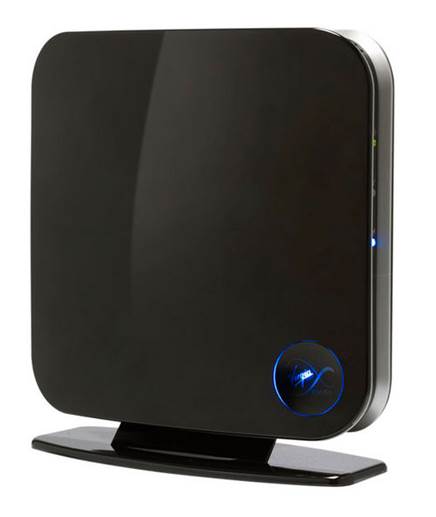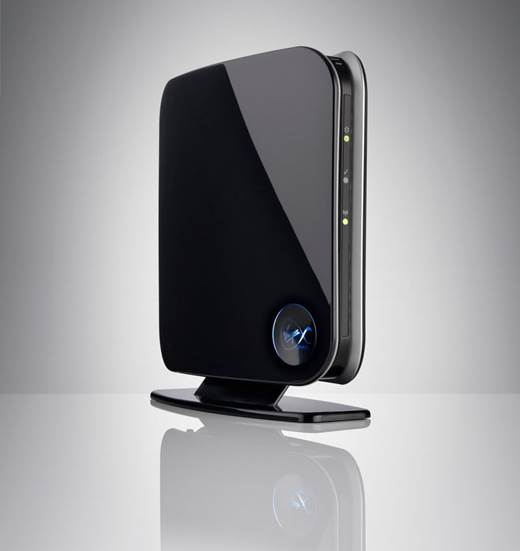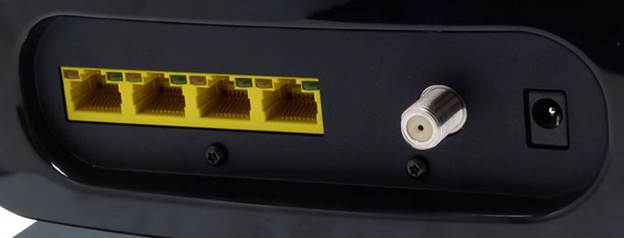Virgin Media Hub
A basic router, despite 5GHz support,
but wireless performance isn't terrible
With ISP-provided routers, our advice has
so far been “replace it as soon as you can”. With the Netgear-manufactured
Virgin Media Hub, however, you might want to think again. It’s a competent
piece of kit.
As with the BT Home Hub 3 and the Sky Hub,
features are thin on the ground. The router is nominally dual band, but those
networks can’t be run concurrently, so unless you’re willing to cut off your
2.4GHz devices from the internet completely, the 5 GHz mode is redundant.
Elsewhere, there’s no sign of advanced, router-based parental controls, no USB
ports for sharing storage, no mobile app management of settings, and no
configurable QoS settings.

Virgin
Media Hub
However, it allows for more flexibility
than either of its ISP-supplied rivals. It has four Gigabit Ethernet ports
where the others have only 10/100 Ethernet. It also boasts guest-network
capabilities, so you don’t have to give full access on the home network to
visitors who need internet connectivity.
In terms of performance, it puts its
freebie rivals to shame. At close range, we recorded an average of 13.4MB/sec
over 2.4GHz, which places the Virgin Media Hub firmly in the top half of the
speed table. It’s less impressive at long range, with an average transfer rate
of 2.7MB/sec placing it third from the bottom, but it’s faster than the Netgear
DGND4000 and Sky Hub.
If you find you need a greater range or
more features, the Virgin Media Hub can be converted into a standalone modem by
clicking a button in the web-based user interface. This allows you to hook up
any cable router.

In
terms of performance, it puts its freebie rivals to shame
The only thing that really irritates us is
the bright-blue, backlit Virgin Media logo on the front, which can’t be
disabled.
That aside, we’re quietly impressed with
the Media Hub: it’s quick, has a reasonable set of features, and doesn’t try to
lock you in.

The
only thing that really irritates us is the bright-blue, backlit Virgin Media
logo on the front, which can’t be disabled
Virgin Media Hub
Pricing
·
Part code: VMDG480
·
Price: Free with all Virgin Media contracts
·
Supplier: www.virginmedia.com
·
Dimensions inc antennae (WDH): 193 x 74 x 203mm
·
Warranty: Lifetime
Core specifications
·
Internet connection type: Cable
·
Dual band (2.4GHz/5GHz): yes
·
Concurrent dual band: no
·
Wireless standards: 802.11 abgn
·
Maximum throughput (2.4GHz/5GHz):
300/300Mbits/sec
·
40MHz channels (2.4GHz/5GHz)
·
Gigabit Ethernet ports: 4
·
10/100 Ethernetports: no
·
USB ports (device support type): no
·
Security and parental controls
·
Security types: WEP, WPA (personal, enterprise),
WPA2 (personal, enterprise)
·
Web content filtering: no
·
URL whitelisting: no
·
URL blacklisting: yes
·
Schedule-restricted internet access: no
·
WPS button/router PIN/device PIN support: yes/
yes/ no
Other
·
IPv6 support: no
·
Wireless repeater functions: no
·
Wireless on/off switch : no
·
Power switch: no
·
User-configurable QoS: no
·
Media server: no
·
Torrent server: no
·
Storage format support: N/A
·
Guest network: yes
·
Android/iOS app: no
·
Extendability via apps: no
·
Online firmware updating: yes
Measured average speeds (MB/sec)
·
2.4GHz short range: 13.4
·
5GHz short range: 13.7
·
802.11ac short range: N/A
·
2.4GHz long range: 2.7
·
5GHz long range: FTC
·
USB speed (wired): N/A
·
ADSL download (wired): N/A
View From The Labs
There were some things in this Labs that
didn’t surprise us: the fact that the ISP-supplied routers were more sparsely
featured than their third-party counterparts; the fact that, without exception,
they were all slower and less flexible; and the fact that every one of them
struggled to compete with the best in the Labs when it comes to wireless
coverage.
If you want to make the most of your home
network - to manage it remotely, restrict internet access to children with any
degree of control, stream video reliably, or use your router as a basic NAS
drive - you have to spend a little more cash. If you want good speed close up
and at long range, buy one of our award-winners rather than sticking with what
you have. Either the Asus DSL-N55U or the Netgear DGND4000 will do the job
admirably.
However, there was one big surprise this
month. Our findings on the new 802.11ac routers revealed that, as yet, there’s
very little reason to go all out for the new standard. The reason isn’t that
the standard itself is immature, nor that the routers themselves aren’t fast
enough: it’s simply that the rest of the technology industry has yet to catch
up. In order to obtain the speeds promised by 802.11ac, absolutely every part
of the chain, from source to destination, has to support the new protocol or be
capable of speeds equal to that of the router or faster.
That means the adapter embedded in your
laptop, phone or tablet; the Ethernet connection used by your wired components;
the Ethernet connections on the router itself (10/100 Ethernet simply won’t
suffice); and the interface between the wireless adapter and your device’s
central storage.
As it stands, we’re a long way from being
at this stage. Very few client devices make full use of the 802.11n standard
these days, let alone 802.11ac. Most dual-band adapters embedded in laptops and
other devices support a maximum of 2x2 MIMO streams, for instance; only a 3x3 configuration
ensures the fastest speeds possible under 802.11n.
Indeed, even while manufacturers produce
802.11ac routers capable of theoretical speeds three times as fast as 802.11n,
they too are guilty of undermining the onward march of progress. Most of the
802.11ac adapters we tested are rated at 867Mbits/sec, yet their physical
interface -USB 2 - is capped at 480Mbits/sec. None of them provided enough
oomph to complete our long-range test. Only Edimax produces a USB 3 802.11ac
adapter, and even then, with every bottleneck seemingly eliminated, our tests
revealed little real-world advantage to having 802.11ac.
Perhaps it’s only a matter of time before
every smartphone, tablet and laptop has an 802.11ac adapter in it, at which
point (at close range at least) we should all be able to enjoy USB-like network
streaming and file transfer. Until that begins to happen, however, 802.11n will
continue to dominate the market, and it’s the technology we’ll continue to
recommend.